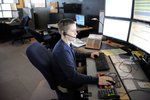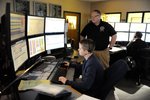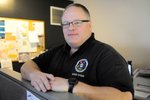 Narrowsburg
NarrowsburgLight Rain Fog/Mist, 43°
Wind: 8.1 mph
WHITE LAKE, NY — The Sullivan County E-911 Communications Center, a centralized dispatch service, located at the Sullivan County International Airport, was established in 1987.
In the early …
Stay informed about your community and support local independent journalism.
Subscribe to The River Reporter today. click here
This item is available in full to subscribers.
Please log in to continueNeed an account?
|




Related
WHITE LAKE, NY — The Sullivan County E-911 Communications Center, a centralized dispatch service, located at the Sullivan County International Airport, was established in 1987.
In the early years, it operated in a small space, fielding calls from individual fire companies that answered their own landline phones, and then sent out the calls for help through an answering service in Liberty.
“Then some fire departments and ambulance corps determined it would be best to have a centralized dispatch system operating out of a single room at the airport, with two dispatchers who received calls on a seven-digit number,” said Alex Rau, the county’s E-911 coordinator.
For the record, this old number, 845/583-7100, is still active, but people in need of emergency assistance in case of fire, medical issues or law enforcement response should always call 911.
“As time went on and technology advanced, there was a need for Sullivan County to get on the bandwagon with 911, so in 1999 we flipped the switch, and in 2000 moved into this building, which became the 911 center,” said Rau, a 26-year veteran of the emergency medical services (EMS) community.
According to the center’s mission statement, Sullivan County E-911 is tasked “to provide all residents and visitors with professional, expedient and efficient 911 dispatch services for all fire, EMS and police emergency calls. To answer all non-emergency calls promptly, professionally and courteously and either resolve the caller’s issue or refer the caller to the appropriate person or agency that can resolve the issue.”
At present, the county’s E-911 communications center provides services to the area’s 40 fire departments, all 15 ambulance corps, and nine law enforcement agencies, including the New York State Police, New York State Department of Environmental Conservation and officers of the New York Department of Environmental Protection.
Last year, the center processed 91,625 telephone calls and dispatched agencies to 39,280 of them, an increase of 4,011 calls.
That breaks down to 6,407 fire calls, 14,906 EMS calls and 17,967 police calls.
All categories saw an increase over 2020—18 percent, 12 percent and eight percent respectively.
In 2020, the center handled 35,269 calls, dispatched 5,445 fire calls, 13,228 EMS and 16,596 police.
And on top of that, “The call volume increases about four times in the summertime,” said Rau. “It can get pretty busy.”
One thing the center’s dispatchers don’t enjoy getting are those calls when folks put their iPhones in a back pocket, and if the pressure on a couple of buttons is just right, the smartphone autodials 911 as an SOS feature.
The dispatchers can’t determine if it’s a real emergency call, so agencies are dispatched just to make sure. Particularly if “there are suspicious sounds in the background or somebody is yelling,” he said.
“Be selective; try to be conservative,” said Rau, when it comes to calling 911. But when in doubt, don’t hesitate to call for assistance, making certain to give the answering dispatcher as much information as you can, including the type of emergency, exact location and your name and contact information.
On the flip side, if you have chronic back pain or a sore tooth that’s been giving you fits for a couple of weeks, think at least twice before dialing 911, as you’d be tying up emergency resources.
As noted on the county’s website posting explaining the communications center, “911 is the first link in the medical survival chain... Critical procedures such as CPR, airway management and childbirth, just to name a few, can be started before more advanced help arrives.”
The center employs 16 full-time dispatchers, along with three part-timers, all with at least three years of EMS, fire or police experience. They are, in Rau’s words, “active in the field of emergency services, so they have a flavor of what goes on in the field.”
Education for the cadre of highly dedicated dispatchers to become certified public safety communicators involves a basic 40-hour class and a three-month training period, followed by a six-week online class, CPR and Narcan instruction. There’s “a lot of on-the-job training,” and 21 hours of continuing education every year.
“Our compass for helping people is always to treat every caller like it’s your mom or dad, always do the right thing for the caller and the patient,” said Rau.
Noting that the current 911 system is still derived from phone company-monitored databases, Rau said that 911 will soon be entering into what he called the “next-generation 911.” A committee is looking into how “we are going to receive calls… pictures of evildoers sent to us as photos, then sent to law enforcement responding units… and text messages disseminated to people in the field.”
Asked why he got into EMS and later E-911 communications, Rau replied, “It’s a rewarding career to be able to help people in their time of need. We are the first interface with the public in an emergency… we are the first first responders.”
Related stories

Comments
No comments on this item Please log in to comment by clicking here